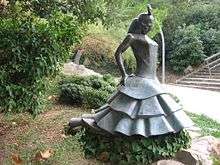Carmen Amaya
| Carmen Amaya | |
|---|---|
| Born |
2 November 1913 Barcelona |
| Died | 19 November 1963 (aged 45) |
| Occupation | Flamenco dancer |
| Years active | 1926-1963 |
Carmen Amaya (2 November 1913[1]– 19 November 1963) was a flamenco Gypsy dancer (Romani) and singer, born in the Somorrostro slum of Barcelona, Spain.
She has been called "the greatest Spanish gypsy dancer of her generation"[2] and "the most extraordinary personality of all time in flamenco dance".[3]
Early life
Carmen Amaya was born on 2 November 1918[1] in a slum of Somorrostro, Barcelona, Spain, to José Amaya Amaya and Micaela Amaya Moreno. She came from a very poor family that lived in a wagon. She was born under their wagon turned home during an early winter storm.[4] Amaya was the second of six surviving children; three sisters and two brothers. At a very early age, she learned flamenco from her mother, aunt and many other famous dancers of that time.[5]
Career

Amaya first danced in a cave near Granada, Spain.[6] She danced from the time she was five years old. Accompanied on the guitar by her father, she danced in waterfront taverns in Barcelona. A young person who saw her dance as a girl was Sabicas (Agustín Castellón Campos), who later said "I saw her dance and it seemed like something supernatural to me... I never saw anyone dance like her. I don't know how she did it, I just don't know!". Sabicas became a great flamenco guitarist and accompanied her for many years.[7] He recorded Queen of the Gypsies (1959) and Flamenco! with Amaya.
In 1929, she made her debut in Paris with noted Spanish dancer Raquel Meller, to warm acclaim and admiration of her dancing skills. She then performed at the Folies Bergère. She declined an offer to perform in Buenos Aires until she was called to appear in Madrid. After this acclaimed performance, she accepted the Buenos Aires offer, in spite of protestations from her uncle Sebastian, one of the sixteen members of her entourage. Argentine audiences were so impressed that they named a theater after her. She then toured in different countries of South America, and in Mexico City she was signed by S. Hurok, who brought her to New York City.[8] She moved to the United States in 1936, where she went on to act in several films that garnered critical acclaim and broke box office records, including the Romeo and Juliet adaptation Los Tarantos, and short film Danzas Gitanas (Spanish for Gypsy dances).
Amaya was invited by president Franklin Roosevelt to dance in the White House in 1944, and also by Harry S. Truman in 1953.
Amaya is buried in the Cemetery of Ciriego at Santander.
Selected filmography
- Juan Simón's Daughter (1935)
- When Do You Commit Suicide? (1953)
References
- 1 2 Montse Madridejos and David Pérez Merinero (2013). Carmen Amaya. Barcelona: Edicions Bellaterra. p. 21. ISBN 978-84-7290-636-5.
- ↑ Clarke, Mary & Crisp, Clement 1981. The history of dance. Orbis, London. p60
- ↑ Clarke, Mary & Vaughan, David 1977. The encyclopedia of dance & ballet. Pitman, London. p316
- ↑ Dublin 2009, p. 27.
- ↑ Dublin 2009, p. 28.
- ↑ Herbert Kadison. "Flamenco Firebrand." Greenwich Village Chatter II:11 (October, 1946), 5-7.
- ↑ Sevilla, Paco 1999. Queen of the gypsies: the life and legend of Carmen Amaya. Sevilla Press. Excerpt by Flamenco-world.com: "Archived copy". Archived from the original on 2003-02-19. Retrieved 2003-01-24.
- ↑ (Kadison, 6)
Bibliography
- Dublin, Anne (2009). Dynamic Women Dancers. Second Story Press. ISBN 978-1-897187-56-2.
- Bois, Mario (1994). Carmen Amaya o la danza del fuego. Madrid: Espasa Calpe.
- Hidalgo Gómez, Francisco (2010). Carmen Amaya. La biografía. Barcelona: Ediciones Carena.
- Madridejos Mora, Montserrat (2012). El flamenco en la Barcelona de la Exposición Internacional (1929-1930). Barcelona: Edicions Bellaterra.
- Madridejos Mora, Montserrat y David Pérez Merinero (2013), Carmen Amaya. Barcelona: Edicions Bellaterra.
- Montañés, Salvador (1963). Carmen Amaya. La bailaora genial. Barcelona: Ediciones G.P.
- Pujol Baulenas, Jordi y Carlos García de Olalla (2003). Carmen Amaya. El mar me enseñó a bailar. Barcelona: Almendra Music.
- Sevilla, Paco (1999). Queen of the gypsies. The Life and legend of Carmen Amaya. San Diego, EE.UU: Sevilla Press.
External links
| Wikimedia Commons has media related to Carmen Amaya. |
- Carmen Amaya at Papelesflamencos.com
- Short biography of Carmen Amaya at Historiasdeflamenco.com
- Carmen Amaya biography and related products
- Carmen Amaya description on her grandniece's website
- "Queen of the Gypsies", a portrait of Carmen Amaya, video clips from the documentary
- Centennial special: Carmen Amaya